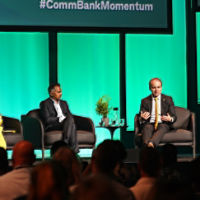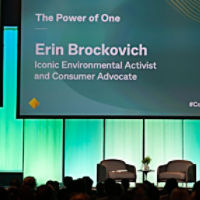Optimism about Australia’s energy future
A panel dedicated to discussing Australia’s energy future explored how to meet the ambitious goal of supporting approximately 5.5 gigawatts of new electricity generation every year to meet the federal government's 2030 energy target. The session discussed the best path forward to deliver the energy transition and how industry can seize key opportunities and overcome major obstacles as we approach this critical milestone on the path to net zero. The speakers shared their optimism for the future, and commended the commitment, intelligence and passion of their purpose-driven teams that are driving the energy transition forward.
Tim Nelson, Iberdrola Australia’s Executive General Manager, Energy Markets, celebrated the advances already being made: “There have been a lot of people saying, ‘Oh we'll never get it done on time. It'll be too expensive,’ and they've been wrong every time. Markets have found a way to get that investment into the market and get that new supply in,” he said.
Businesses face challenges deploying AI solutions sustainably
Artificial intelligence brings new benefits such as accelerating innovation and maximising value and productivity, but it also increases the demands on digital infrastructure — which results in higher electricity usage, posing a conflict with environmental regulations. Intel has a three-pronged approach to sustainability: reducing environmental footprint, building sustainable products and solutions and collaborating with stakeholders. Their holistic approach combines hardware and software innovations with open-source solutions to help lower the footprint of digital infrastructure. Intel sees AI as a powerful tool to improve sustainability across various sectors such as agriculture, healthcare, and energy management. By leveraging AI techniques like smart agriculture and optimisation tools, businesses can increase productivity, reduce waste and enhance the customer experience while lowering their carbon footprint.
Retrofitting is critical on our path to net zero
With 60 per cent of carbon emissions within cities being attributable to buildings, retrofitting existing buildings will be critical on our path to net zero. Although more environmentally friendly buildings are increasingly attractive to investors and tenants, Annabel MacFarlane, head of strategic research at JLL, warned “regulatory frameworks globally are moving from carrots to sticks.” “Market-leading characteristics will have to apply to everyone and emissions reporting will be requirements for all businesses,” she said, noting that New York is already pioneering new emissions laws for buildings which would likely take off elsewhere.
Bram Adema, founder and managing director at CFP Green Buildings, commended the Australian NABERS model which measures building sustainability through carbon emissions, rather than credits, while acknowledging that knowing where to start can be challenging for commercial property owners and developers. Last year, CBA launched the Green Buildings Tool in partnership with CFP – to help commercial property owners identify and implement investments that uplift the sustainability of their building operations.
Funding first-of-its-kind plants is a key challenge for scaling emerging climate tech
Traditional venture capital firms aren’t well setup to help scale climate technology, says Wollemi Capital Managing Director and co-founder, Paul Hunyor. The traditional VC mindset, summed up as "move fast and break things", can work well to prove efficacy of a particular technology. However, it then takes a different set of skills to commercialise that technology all the way to an infrastructure-scale investable asset. "These teams do not really understand permitting construction risk, manufacturing risk and all of these elements of project-level de-risking,” he said. This skills gap presents a challenge for funding first-of-its-kind plants required to commercialise and scale climate technology – a challenge that Wollemi is focused on tackling, Hunyor said.
Read about CBA’s investment in Wollemi Capital.
‘Face into the storm’ to tackle climate change
There aren’t many people who know more about how one person can change the lives of millions than famed environmental advocate Erin Brockovich, who was famously played by Julia Roberts in the Academy Award-winning film about how a single mother and legal assistant exposed a massive corporate cover-up of groundwater contamination.
In her keynote address, Ms Brockovich encouraged her audience to tackle the challenge of climate change by returning to the analogy of buffalo: strong, wild animals that face into storms.
“Because [a buffalo] knows if it faces the storm, it gets through it faster, and if it turns its back to the storm, the worst side catches them — the winds,” Ms Brockovich said. “And that is a little of what we’ve done – we've turned away from the storm, and I’m going to ask everyone now, it’s time for us to turn into the storm.”
Read more about Erin Brockovitch’s Momentum keynote.
Written by:
- Annabelle Bamford
- Georgia Burns
- Gigi Sardelic
- Kate Patterson
- Primrose Clarke
- Samantha Danckert
- Samantha O’Brien
- Sam Downing
- Tatyana Shumsky





